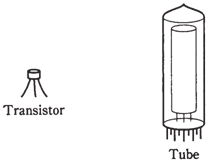Semiconductor revolution
It was not too long ago when the vacuum tubes were the backbone of electronic equipment. Even in the radio receivers and portable television sets, all the amplifiers, detectors, oscillators, and other circuits needed these devices. A typical vacuum tube ranged from size of your thumb to size of your fist.
A radio might sit on the table in living room; if you wanted to listen it, you would turn it on and then wait for the tube filaments to warm up. It makes them feel like an old man to think of it. Vacuum tubes, sometimes called as tubes or valves, are still used in some microwave oscillators, power amplifiers, and video display units. There are a few places where the tubes work better than the semiconductor devices. Tubes tolerate momentary voltage and current surges better than the semiconductors.
Tubes require rather high voltages to work. In radio receivers, turntables, and other consumer devices, 100 V to 200V direct current was required when tubes were used. This mandated the bulky power supplies and resulted electrical shock hazard. Nowadays, a transistor of the size of a pencil eraser can perform functions of a tube in most of the situations. Often, power supply can be a couple of AA cells or a 9-V transistor battery.In the figure given below is a size comparison drawing between the characteristic transistor and a characteristic vacuum tube.

Figure-- Transistors are smaller than tubes.
Integrated circuits, which are hardly larger than the individual transistors, can perform the work of hundreds or even the thousands of vacuum tubes. The perfect example of this technology is found in personal computer, or PC. In the year 1950, a PC would have occupied a large building, needed thousands of watts to operate, and cost well over a million dollars. In present you can buy one and carry it in your briefcase.